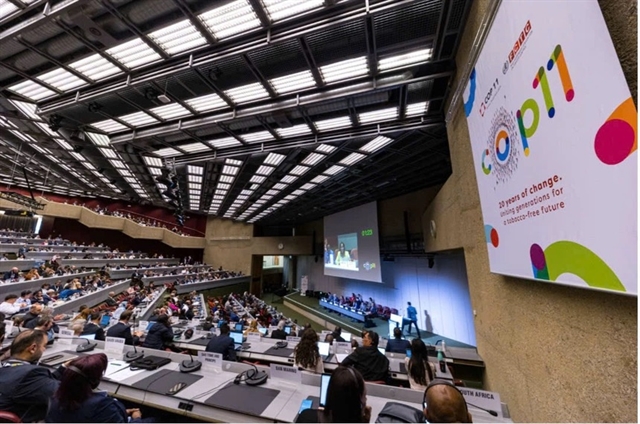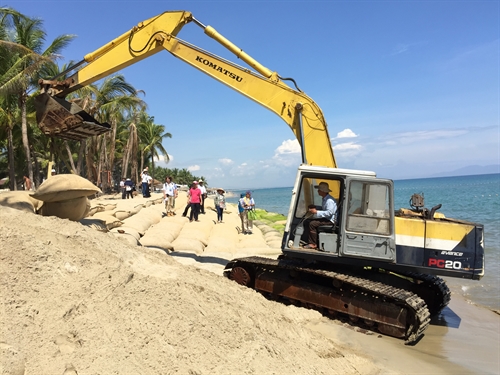 Society
Society

The central province of Quảng Nam has approved the second phase of a project to build concrete dykes along Cửa Đại beach to cope with worsening coastal erosion near Hội An, a UNESCO World Heritage Site.
 |
| Local authorities built a sandbag revetment along Cửa Đại beach in Hội An last year to deal with the worsening erosion along the coast. - VNS Photo Bồ Xuân Hiệp. |
HCM CITY — The central province of Quảng Nam has approved the second phase of a project to build concrete dykes along Cửa Đại beach to cope with worsening coastal erosion near Hội An, a UNESCO World Heritage Site.
Nguyễn Văn Dũng, chairman of Hội An’s People’s Committee, said the project, with total investment of more than VNĐ80 billion (US$3.59 million), would be funded with VNĐ50 billion ($2.24) from the central government’s budget and the rest from Hội An.
Under the project, 750 metres of concrete dykes will be built from the Vinpearl resort area to the river mouth of Cửa Đại beach.
During the first phase of the project in 2011, more than 850 metres of dykes were built at a total cost of VNĐ70 billion ($3.14 million).
In 2014, when the erosion became worse, the province spent VNĐ25 billion ($1.12 million) to erect iron poles and set up a sandbag revetment 400 metres along the coast. However, the project was not effective in the long run.
The province is now asking for the Government to allocate VNĐ40 billion ($1.79 million) to help eroded areas stretching 1.3 kilometres along the coast. It will use Dutch technology, with a total investment of VNĐ55 billion ($2.46 million).
Nguyễn Thế Hùng, vice chairman of the city’s people’s committee, said Cửa Đại beach erosion had become more serious, destroying the beach and affecting the tourism industry in Hội An.
Experts said at an international conference recently held in Hội An that the coastal erosion at Cửa Đại was a serious problem not only for Hội An but for the entire province.
Many provinces in the central region had not developed long-term plans for the sustainable development of rivers, estuaries and coasts.
Nguyễn Thế Hùng, vice chairman of the city’s people’s committee, told Việt Nam News on the sidelines of the conference that all sand-mining activity should be strictly banned in the downstream areas of the Thu Bồn and along the province’s coastline.
More specialised dykes, other than sandbag revetments, should be built to shield Cửa Đại beach from further attrition, he said.
Local scientists have also said that protective forests should be planted and new measures taken to retain the soil.
However, the Hội An government lacks the funding, technology and knowledge to resolve the problem and is waiting for support from the province and the central Government, according to Hùng.
Nguyễn Trung Việt, rector of the Central Region College of Technology, Economics and Water Resources, said in an interview that temporary solutions would not achieve sustainable outcomes and might do the opposite.
Such measures could cause erosion in neighbouring areas. For example, some resorts have built their own dykes independently without co-ordination with others. These activities could cause erosion at nearby hotels and resorts, Việt said.
Co-operation between scientists, businesses and provincial authorities is needed to effectively resolve the issue, he said.
The city’s people’s committee has asked the province’s people’s committee and the central Government for additional funds for soil retention, and has also sought advice from experts.
Cửa Đại Beach, which is 7.6km long, was 3km away from the shore 40 years ago. It was separated from the residential areas by huge sand dunes, according to local residents.
However, in recent years, erosion has eaten into the land at an alarming level. Hundreds of households have moved to other places due to serious coastal erosion. — VNS




